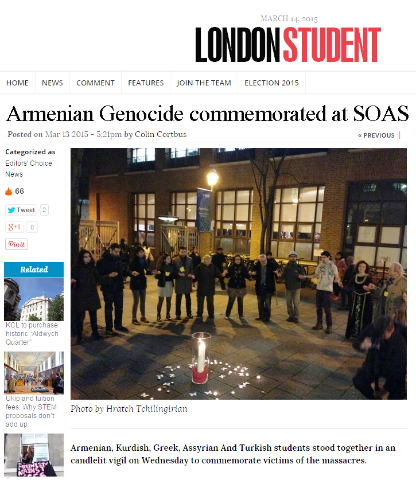Armenian Genocide commemorated at SOAS
London Student - 13 March 2015 - 5:21pm Colin Cortbus
Armenian, Kurdish, Greek, Assyrian And Turkish students stood together in an candlelit vigil on Wednesday to commemorate victims of the massacres.
Holding candles in solemn silence, students and activists formed a “circle of life” to mark 100th anniversary of the Armenian & Assyrian Genocide. Later they joined hands to perform a series of traditional, and at times emotional Armenian dances.
Those present wore butterfly shaped badges that bore names of over 50 peoples subjected to genocide in the past century in a remarkably inclusive and open ceremony. Genocides also commemorated included the Holodomor genocide in Ukraine, the Holocaust, and the Rwandan Genocide.
Artist Shakeh Major Tchilingirian told attendees “As we join hands and take steps together, we not only remember the victims but, more significantly, we affirm the dignity and value of lost human lives… With our presence here tonight, we show our determination and collective strength to stand up against injustice and inhuman treatment of fellow human beings”.
Event organiser Hratch Tchilingirian emphasised that the event was aimed to foster civic culture and reconciliation: “We wanted to emphasize the essential human and moral dimensions of the societal rupture that genocide causes and the process of reconciliation through living culture”.
The forming of a circle by attendees was meant as a powerful symbolic gesture, with circular motifs symbolising eternity, and hence survival, in medieval and traditional Armenian iconographical culture.
An exhibition in the SOAS foyer accompanied the event. Maps and documentary evidence were used there to tell the horrific and tragic story of over 1.5 million Armenians and Assyrians subjected to genocide from 1914 onwards by “Young Turk Movement” Ottoman forces and their collaborators. According to expert Prof. Vahakn Dadrian, the mass-slaughter continued until 1920/1921, when forces under the Turkish general Kazim Karabekir killed an estimated 100000 Armenians in a “mini-genocide” as part of a war against the newly independent eastern Armenian state. The exhibition at SOAS also featured a section dedicated to the “real Turkish heroes of 1915“, brave officials and ordinary people who risked their lives and sometimes paid the ultimate price to save Armenians from massacre at the hands of the Young Turk-led reactionary, undemocratic and ultranationalist regime.
The Turkish State continues to deny the genocide, and those speaking out about it in Turkey risk persecution for “insulting the Turkish nation” under article 301 of the Turkish Penal Code. In Summer 2007 Turkish Armenian journalist Hrant Dink was assassinated after speaking out about the genocide, prompting a wave of outrage from Turkish human rights defenders and the international community.
Nonetheless, just months later a Turkish state penal court sentenced Dink’s mourning son Arat to a suspended term of one year’s imprisonment under Article 301 for republishing an interview his father gave regarding the Armenian genocide.
The vigil aimed to draw attention to these cases, and those attending expressed anger and frustration at the Turkish state for their denials.



